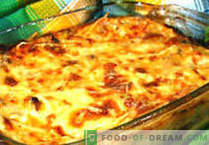
Honeysuckle Jam - General Description
Honeysuckle is a sweet and sour blue berry, similar to blueberries, but more oblong. There are different varieties of honeysuckle, different in acid content, astringency, etc. Honeysuckle is used to make jams, compotes, juices. Honeysuckle jam is prepared before all other berries - strawberries, cherries, cherries, etc.
Honeysuckle is rich in vitamins and microelements. In particular, honeysuckle berries are a source of vitamins C, A, B group, glucose and fructose, organic acids. Vitamin C they contain as much as lemon and kiwi. The amount of magnesium and sodium honeysuckle exceeds all berries, the amount of potassium compared with her only lingonberry, and the content of P-active substances, it is the clear leader among the berries, overtaking even rosehip.
Honeysuckle berries are also rich in manganese, copper, silicon, zinc, aluminum, barium, iodine. It has been proven that it effectively eliminates joint pain, lowers blood pressure, normalizes digestion.
Depending on the place of gathering, honeysuckle berries contain different amounts of certain chemicals, and, therefore, they have different taste properties. Berries growing in a hot climate have less acidity and a higher content of sugar, tannins and coloring matter, which causes a slightly bitter taste of berries. The cool climate contributes to the acidity of the honeysuckle berries and an increase in the content of vitamin C. Berries collected in places with a temperate continental climate have a sweeter taste and elevated levels of sugar and vitamin C.
Honeysuckle Jam - Cookware Preparation
For storage of honeysuckle jam is best to use small banks, for example, with a capacity of 0.5 liters. To destroy the bacteria that can cause food spoilage, the banks are sterilized. However, you should first make an audit of the container, carefully washing the jars and checking them for the presence of chips and cracks. The covers should also be checked; only clean and even ones will do for us. Metal caps for seaming must be rust-free and have a new gum (gasket). After such an audit, you can proceed to sterilization. The most affordable method that destroys all harmful microorganisms is high temperature sterilization. It is very important to ensure the preservation of the cans during sterilization, since the glass from which they are made is not very sensitive to temperature differences and can crack. The same applies to rapid cooling.
The main methods of sterilization of cans at home include:
- sterilization of cans with steam;
- sterilization of cans in the oven;
- sterilization of cans using a microwave.
Also, planning to make jam, you should prepare a large enamel pot or bowl, or a copper basin, kitchen scales, a wooden spatula for stirring the jam, a ladle (in order to pour it neatly into the jars).
Honeysuckle jam - preparation of berries
When choosing berries for jam, it should be remembered that they should be fresh, not overripe, without damage, defects and rot. Therefore, they should be carefully selected, cleared of leaves and twigs. Then rinse under running water, let it drain and then dry on a clean cloth.
Honeysuckle Jam - Recipe 1
1. In a cooked saucepan or bowl pour 200 gr. water and pour 1 kg of sugar, stirring slowly, bring to a boil.
2. After the sugar has dissolved, boil the syrup over low heat for about 10 minutes.
3. Prepared honeysuckle berries (1 kg) are placed in boiling syrup and, when boiled, remove from heat and put the dishes and jam in a cool place, leave for 7 hours, you can overnight.
4. After this time has elapsed, put it on fire again and boil for 15 minutes with gentle stirring, removing foam if necessary.
5. Pour hot jam into prepared sterilized jars and close the capron lids.
Honeysuckle Jam - Recipe 2
1. Prepared honeysuckle berries in the amount of 1 kg put in a saucepan and, having filled up 1 kg of sugar, leave for 3-4 hours until the berries let the juice. 2. After placing the dishes with the berries on the fire, cook for 5 minutes, then set aside for 8 hours.
3. Then, putting the jam on the fire, cook it until ready for about 15 minutes.
4. Pour hot jam into prepared sterilized jars and close the capron lids.
Honeysuckle Jam - Recipe 3
1. Cooking syrup from 200 gr. water and 1 kg of sugar in the recipe №1.
2. Immerse in it 1 kg of prepared honeysuckle berries and soak in syrup for about 4 hours so that the berries are soaked.
3. After that, boil the jam for about 5 minutes and again set it aside for 6-8 hours.
4. Then again, placing the container of jam on the fire, boil until cooked with gentle stirring (until the berries stop floating).
5. Pour hot jam into prepared sterilized jars and close the capron lids.
Honeysuckle Jam - useful tips from experienced chefs
In order to prevent sugaring, at the last cooking of honeysuckle jam, citric acid is added to it (1 gram per 1 kg of jam).
For jam, it is better to choose a honeysuckle variety with a slight sourness, so that it does not have a cloyingly sweet taste.
Some cooks believe that cooking honeysuckle a second time is not necessary, so that the berries do not shrivel, you just need to increase the amount of sugar in a single cooking, taking it 1.5 kg per 1 kg of berries.
Store honeysuckle jam should be in the closet, in the cellar, it is possible on the balcony, as it does not freeze in the cold, retaining all its beneficial properties.























